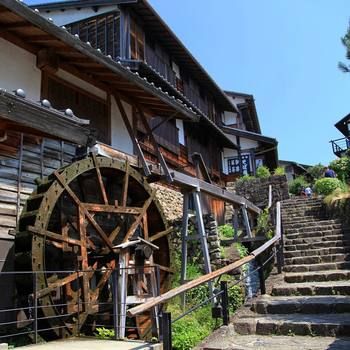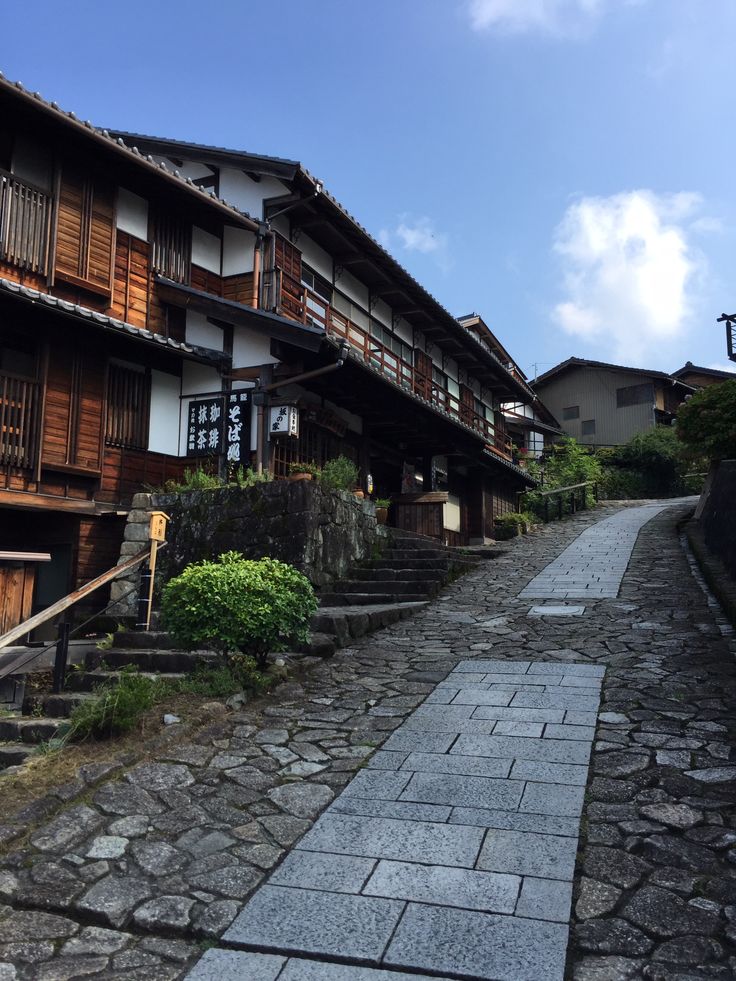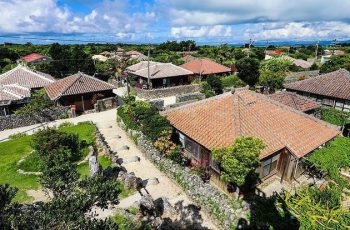The morning sun, still low in the sky, cast long, cool shadows across the weathered cobblestones of Magome-juku. Kenji, his backpack feeling lighter after a restful night in Tsumago, took a deep breath of the crisp Gifu mountain air. He was at the southern end of the historic Nakasendo Trail section that famously connected Tsumago and Magome, two beautifully preserved post towns. Having already immersed himself in the quiet authenticity of Tsumago, he was eager to experience its Gifu counterpart, Magome, renowned for its steep, winding main street, its charming tea houses, and its own unique character.
The hike itself had been an experience to savor. The well-maintained path, in places the original ishidatami (stone paving) of the Edo period, had led him through dense forests of hinoki and cedar, past gurgling streams, and alongside small, terraced farm plots clinging to the mountainsides. He’d passed the Odaki-Medaki waterfalls, their roar a refreshing counterpoint to the forest’s hush, and paused at the Tateba Chaya, a replica Edo-period rest stop where a kindly volunteer offered travelers free tea and a place to rest their weary legs. The eight-kilometer journey was more than just a physical trek; it was a meditative passage through time, each step echoing the countless travelers – samurai, merchants, pilgrims, and commoners – who had trod this very route for centuries.

As he approached Magome, the character of the landscape began to shift subtly. The path steepened, and then, rounding a bend, the village unfolded before him, dramatically different from Tsumago’s gentle valley setting. Magome-juku was built entirely on a steep hillside, its main street a continuous, winding slope of beautifully laid cobblestones, flanked by traditional wooden buildings that seemed to cling to the incline with an elegant tenacity.
The immediate impression was one of vibrant, picturesque charm. While Tsumago exuded a quiet, almost austere authenticity, Magome felt a touch more bustling, its array of shops, tea houses, and inns perhaps a little more geared towards the steady stream of hikers and visitors. Yet, it lacked any sense of artificiality. The buildings, with their dark, weathered wood, latticed windows, and overhanging eaves, were clearly historic, lovingly maintained. The absence of visible power lines, a shared commitment with Tsumago, ensured an unbroken vista of traditional architecture against the backdrop of the Kiso mountains.
Kenji began his ascent up the main thoroughfare, a street some 600 meters long that climbed steadily from the lower entrance to the viewpoint at the top. The cobblestones, worn smooth by centuries of foot traffic and the iron-rimmed wheels of carts, provided a sure footing. On either side, traditional structures housed a delightful array of establishments. There were minshuku (guesthouses) with inviting noren (doorway curtains) fluttering in the gentle breeze, their names often hinting at a long history of hospitality. Artisan shops displayed local crafts: intricately carved wooden products from the Kiso region, hand-dyed textiles, and locally made sake and miso.

The aroma of roasting tea leaves drifted from a charming tea house, its open front revealing tatami mats and low tables where visitors were enjoying refreshments. Further up, the enticing scent of gohei-mochi – skewered rice cakes basted with a sweet and savory walnut-miso or sesame-miso sauce and grilled over charcoal – wafted from a small stall. Kenji knew he’d be indulging in that local specialty later.
Water, a constant feature of Nakasendo post towns, flowed in stone-lined channels alongside the street, sometimes powering large wooden waterwheels that turned with a rhythmic, creaking groan, adding to the historic soundscape. These weren’t just decorative; they were functional relics of a time when water power was essential for tasks like milling grain.
One of the most prominent buildings was the Toson Memorial Museum, dedicated to Shimazaki Toson, one of Japan’s most celebrated Meiji-era novelists. Toson was born in Magome (though at the time it was part of Nagano Prefecture before boundary changes), and his epic historical novel, Yoakemae (“Before the Dawn”), vividly depicts life in the Kiso Valley during the turbulent transition from the feudal Edo period to the modern Meiji era. The museum, housed in his restored birthplace, offered Kenji, the historian, a poignant insight into the profound social and cultural shifts that had swept through Japan and how they impacted remote mountain communities like Magome. Reading excerpts from Toson’s work while standing in the very rooms he once inhabited felt like a direct communion with the past.
As Kenji continued his climb, he paused frequently to admire the views. Because of its hillside location, Magome offered constantly shifting perspectives. Looking back down the slope, he could see the layered roofs of the houses receding into the distance, framed by the lush green of the surrounding mountains. It was incredibly photogenic, a living postcard of rural Japan.
He stopped at several tea houses during his exploration. Each had its own unique charm. In one, an elderly woman served him matcha green tea and a delicate, seasonally themed wagashi (sweet), her movements precise and graceful. In another, he enjoyed a simpler cup of sencha while watching fellow hikers, their faces flushed with exertion and satisfaction, making their way up the street. These tea houses were not just places for refreshment; they were social hubs, places where stories were exchanged, and the camaraderie of the trail was shared. They were direct descendants of the establishments that had offered respite to Edo-period travelers.
The inns of Magome, like those in Tsumago, varied in size and grandeur, from humble lodgings for common travelers to more substantial establishments that might once have hosted minor officials or wealthy merchants. Many still operated as minshuku, offering visitors the chance to experience traditional Japanese hospitality, sleeping on futons in tatami rooms and enjoying home-cooked meals featuring local ingredients. Kenji imagined the evenings of centuries past: travelers gathering around the irori, sharing news from Edo or Kyoto, their conversations punctuated by the crackle of the fire and the murmur of the mountain wind.
Reaching the top of the main street, Kenji was rewarded with a magnificent panoramic view from the Magome-juku Observatory. The entire village lay spread out below him, a ribbon of traditional roofs winding down the hillside, the Kiso mountains forming a majestic backdrop. He could see Mount Ena in the distance, often wreathed in mist. It was a vista that had undoubtedly inspired Shimazaki Toson and countless other artists and writers.
Here, at the upper edge of the town, the atmosphere felt quieter, more residential. He noticed small, well-tended vegetable gardens tucked behind the houses, and the sounds of daily life – a distant conversation, the clatter of kitchenware – drifted from open windows. It was a reminder that Magome, despite its popularity with visitors, was still a living community, not just a historical exhibit.
Kenji spent the afternoon exploring the side alleys and smaller paths that branched off the main street. He discovered hidden shrines, ancient stone markers, and quiet corners where he could sit and simply absorb the atmosphere. He learned that Magome, like Tsumago, had faced a period of decline when the Chuo Main Line railway was built, bypassing the old Nakasendo route. Its revival and preservation were also the result of a concerted effort by its residents, who recognized the unique value of their heritage.
The craftsmanship evident in the restoration and maintenance of the buildings was remarkable. He noted the careful repair of wooden latticework, the patching of plaster walls using traditional techniques, and the ongoing efforts to maintain the cobblestone paths. There was a deep respect for the original materials and methods, ensuring that Magome retained its authentic Edo-period character.

As evening approached, Kenji found a small, family-run eatery and savored a bowl of sansai soba (buckwheat noodles with mountain vegetables), the flavors clean and earthy. The lanterns outside the shops and inns began to glow, casting a warm, inviting light on the cobblestones. The daytime bustle subsided, replaced by a more tranquil ambiance.
He reflected on the differences and similarities between Tsumago and Magome. Tsumago felt more like a perfectly preserved, almost somber, fragment of the past. Magome, with its dramatic hillside setting and slightly more commercial feel, seemed a little more vivacious, yet equally committed to its historical integrity. Together, they offered a wonderfully complete picture of life on the Nakasendo. The hike between them was not just a journey between two points, but a journey through history, a tangible connection to the hardships and rewards of Edo-period travel.
The cobblestone paths of Magome, worn smooth by time and countless footsteps, were more than just a charming feature. They were the arteries of the village, the pathways that had carried news, commerce, and culture for centuries. The tea houses were not merely places to drink tea; they were oases of rest and conviviality, essential components of the Nakasendo experience. And the inns were not just buildings; they were repositories of stories, shelters that had offered comfort and security to generations of travelers.
Kenji, the historian, felt immensely grateful for the foresight and dedication of the people of Magome and Tsumago. They had not allowed their precious heritage to be swept away by the tides of modernization. Instead, they had carefully preserved it, creating living museums where visitors could step back in time and experience the authentic atmosphere of the Nakasendo.
As he prepared to find his minshuku for the night, the scent of woodsmoke mingling with the cool mountain air, Kenji knew that Magome-juku, with its steep cobblestone slopes, its welcoming tea houses, and its historic inns, would leave an indelible mark on his memory. It was a place where the echoes of the past were not faint whispers, but vibrant conversations, inviting all who walked its ancient paths to listen and to learn. The journey was complete, yet the story of the Nakasendo, he felt, would continue to unfold within him.

